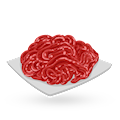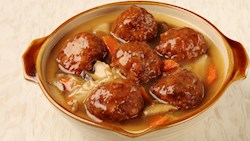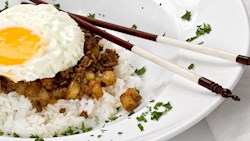MAIN INGREDIENTS
Tire köftesi refers to a special type of ground meat dish that originates from the Tire district of İzmir, Türkiye. Tire köftesi consists of minced meat (often lamb or a mix of beef and lamb), breadcrumbs or stale bread soaked in milk or water, onions, garlic, and various spices.
One distinguishing feature is its soft and juicy texture, which is achieved through its specific mixture of ingredients and cooking method: they are often shallow-fried until they have a crispy exterior, then they might be simmered in a sauce or served directly.
Leskovački roštilj refers to a traditional method of grilling meat which is considered the highest form of barbecue art in Serbia and beyond. Hailing from Leskovac, the technique, according to local belief, is thought to have been brought over from the Caucasus via Turkey, Greece, and Macedonia hundreds of years ago.
Although the exact preparation of the meat remains a secret known only to Leskovac barbecue masters, what is generally known is that the ground mixture traditionally consists of beef that is chopped, ground (first coarsely and then finely), seasoned, and allowed to sit for at least 48 hours before cooking.
MAIN INGREDIENTS
Adana kebap is a popular skewered meat dish named after one of the most famous kebab cities in the country, Adana. This kebab is made with ground lamb and tail fat that are kneaded together with garlic, onion, paprika, and hot red pepper flakes, giving it a deep red color and a spicy flavor.
The whole concoction is typically placed around large and flat metal skewers, then grilled. Once it's done, the grilled meat is traditionally served on a platter over flatbreads, peppers, and tomatoes, or stuffed into pita bread along with a salad consisting of parsley and red onions.
MOST ICONIC Adana kebap
View moreKeema is a stew that is usually prepared as a curry with ingredients such as minced lamb or chicken meat, green peas, ginger-garlic paste, chili, onions, ghee, and garam masala spices. The name of the dish means minced meat in Urdu. Although keema is most popular in north India, Pakistan, and Bangladesh, some believe that the dish has Persian origins due to the fact that it was first mentioned as a recipe in Ain-I-Akbari (a document about emperor Akbar's empire).
Keema is commonly served as a main dish, accompanied by pav buns or naan and other flatbreads. It can also be used as a filling for samosas and parathas.
MAIN INGREDIENTS
Guru khingal is a traditional ground meat dish originating from Azerbaijan. The dish is usually made with a combination of ground meat (lamb or beef), onions, butter, salt, pepper, yogurt, garlic, and homemade square-shaped noodles consisting of flour, eggs, and salt.
The ground meat is fried in butter and seasoned with salt and pepper. The onions are chopped and fried in butter until golden brown, while the noodles are cooked right before serving. The noodles are served on individual plates, topped with melted butter, ground meat, and fried onions, and the dish is ready to be enjoyed, ideally with yogurt-garlic sauce on the side.
MAIN INGREDIENTS
One of the staples of traditional Turkish cuisine, sarma consists of a filling that is snugly surrounded by leaves or leafy vegetables. There are numerous versions of this dish but the mixture typically combines ingredients such as minced meat, rice or bulgur, various herbs, seasonings, red pepper, paprika, ground sumac, or tomato sauce, while the typical wrapping usually includes vine, cabbage, or sauerkraut leaves, or a variety of leafy vegetables such as collard greens and swiss chard.
Having its roots in the Ottoman Empire, sarma is also traditionally consumed in the Balkans, the countries of Central Europe, the South Caucasus, and the Middle East. Although it is commonly enjoyed as a filling lunch or dinner (typically during the winter season), sarma is often prepared on special occasions and holidays.
MOST ICONIC Sarma
View moreMAIN INGREDIENTS
Polpette is a word denoting Italian meatballs, traditionally consisting of ground beef or veal (and sometimes pork) that is shaped into small balls. These meatballs are usually enriched with a wide variety of ingredients such as parsley, eggs, garlic, and sometimes even mortadella or Parmigiano Reggiano.
Although some might think that polpette are served with pasta, that is mostly an American thing, and Italian polpette are typically consumed on their own as a snack, appetizer, or finger food that is especially beloved by children of all ages.
VARIATIONS OF Polpette
MAIN INGREDIENTS
Despite their clear Turkish provenance, Bosnian ćevapi are a source of great national pride and the country's favorite dish. These tiny, hand-rolled minced meat sausages are commonly made with ground beef - or a mix of beef mince with other meats such as veal or lamb - seasoned with a mix of different spices; usually garlic, salt, black pepper, and sometimes paprika or hot red pepper flakes.
After they have mellowed for a couple of hours, ćevapi are barbecued over charcoal. Traditionally, one portion of the dish consists of ten pieces of ćevapi tucked in a soft, moist, slightly grilled flatbread called lepinja or somun, and a variety of accompaniments such as kajmak, a type of clotted cream spread, roasted red pepper and eggplant relish called ajvar (especially popular in Croatia and Serbia), and raw onions.
VARIATIONS OF Ćevapi
MOST ICONIC Ćevapi
View moreMAIN INGREDIENTS
Simple, juicy, and savory lu rou fan is a popular Taiwanese dish consisting of ground pork braised in soy sauce, five-spice powder, and rice wine until it becomes tender and flavorful. It is traditionally served over rice, although some cooks like to replace the rice with noodles.
Sometimes, pickled cucumbers or shiitake mushrooms are served alongside the dish. Literally translated, lu rou fan means stewed meat rice, and the dish is sometimes referred to as Taiwanese ragú. In Taiwan, lu rou fan was originally consumed as a nutritious and healthy meal for farming families, but today it can be found almost everywhere, from home kitchens to restaurants and street stalls.
Kabab koobideh is the Iranian term for a variety of minced meat kebabs usually prepared with onions and finely ground lamb, beef, or chicken. The meat is seasoned with various spices, formed around metal skewers, then grilled on charcoal barbecues.
Whether it is enjoyed as a quick street food item served with lavash bread or as a satisfying dinner accompanied by grilled vegetables and flavorful saffron rice, kabab koobideh is a staple dish eaten throughout Iran.
MOST ICONIC Kabab koobideh
View moreTasteAtlas food rankings are based on the ratings of the TasteAtlas audience, with a series of mechanisms that recognize real users and that ignore bot, nationalist or local patriotic ratings, and give additional value to the ratings of users that the system recognizes as knowledgeable. For the “Top 100 Ground Meat Dishes in the World” list until February 13, 2025, 26,371 ratings were recorded, of which 13,436 were recognized by the system as legitimate. TasteAtlas Rankings should not be seen as the final global conclusion about food. Their purpose is to promote excellent local foods, instill pride in traditional dishes, and arouse curiosity about dishes you haven’t tried.













































































































































